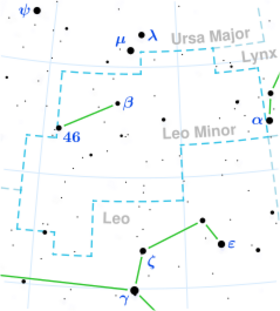Astronomy:32 Leonis Minoris
| Observation data Epoch J2000.0 Equinox (celestial coordinates) | |
|---|---|
| Constellation | Leo Minor |
| Right ascension | 10h 30m 06.44761s[1] |
| Declination | +38° 55′ 30.4758″[1] |
| Apparent magnitude (V) | 5.78±0.01[2] |
| Characteristics | |
| Evolutionary stage | subgiant[3] |
| Spectral type | A4 V[4] or A4 III[5] |
| U−B color index | +0.14[5] |
| B−V color index | +0.07[5] |
| Astrometry | |
| Radial velocity (Rv) | 2±4.3[6] km/s |
| Proper motion (μ) | RA: −16.446[1] mas/yr Dec.: −4.506[1] mas/yr |
| Parallax (π) | 4.4749 ± 0.0527[1] mas |
| Distance | 729 ± 9 ly (223 ± 3 pc) |
| Absolute magnitude (MV) | −1.02[7] |
| Details | |
| Mass | 2.01±0.39[8] M☉ |
| Radius | 6.58±0.33[9] R☉ |
| Luminosity | 241+41−35[3] L☉ |
| Surface gravity (log g) | 3.07±0.37[8] cgs |
| Temperature | 8,511+79−78[3] K |
| Metallicity [Fe/H] | −0.80[10] dex |
| Rotational velocity (v sin i) | 70±8[11] km/s |
| Age | 465[12] Myr |
| Other designations | |
| Database references | |
| SIMBAD | data |
32 Leonis Minoris (32 LMi), also known as HD 90840, is a solitary star[14] located in the northern constellation Leo Minor. It is faintly visible to the naked eye as a white-hued point of light with an apparent magnitude of 5.78.[2] The object is located relatively far at a distance of 729 light-years based on Gaia DR3 parallax measurements[1] and it is currently receding with a heliocentric radial velocity of 2 km/s,[6] which is somewhat constrained. At its current distance, 32 LMi's brightness is diminished by 0.14 magnitudes due to interstellar extinction[15] and it has an absolute magnitude of −1.02.[7]
The object has been given several stellar classifications over the years, ranging from main sequence (V) to giant star (III) and A1 to A4. Two of the classifications are A4 V[4] and A4 III.[5] It has 2.01 times the mass of the Sun[8] but at the age of 465 million years,[12] 32 LMi is now on the subgiant branch[8][failed verification] and it has expanded to 6.58 times the radius of the Sun.[9] It radiates 241 times the luminosity of the Sun[3] from its photosphere at an effective temperature of 8,511 K.[3] 32 LMi is metal deficient with an iron abundance only 15.9% that of Sun ([Fe/H] = −0.80)[10] and it spins modestly with a projected rotational velocity of 70 km/s.[11]
References
- ↑ Jump up to: 1.0 1.1 1.2 1.3 1.4 Vallenari, A. et al. (2022). "Gaia Data Release 3. Summary of the content and survey properties". Astronomy & Astrophysics. doi:10.1051/0004-6361/202243940 Gaia DR3 record for this source at VizieR.
- ↑ Jump up to: 2.0 2.1 Høg, E.; Fabricius, C.; Makarov, V. V.; Urban, S.; Corbin, T.; Wycoff, G.; Bastian, U.; Schwekendiek, P. et al. (March 2000). "The Tycho-2 catalogue of the 2.5 million brightest stars". Astronomy and Astrophysics 355: L27–L30. ISSN 0004-6361. Bibcode: 2000A&A...355L..27H.
- ↑ Jump up to: 3.0 3.1 3.2 3.3 3.4 Zorec, J.; Royer, F. (January 2012). "Rotational velocities of A-type stars IV: Evolution of rotational velocities". Astronomy & Astrophysics 537: A120. doi:10.1051/0004-6361/201117691. ISSN 0004-6361. Bibcode: 2012A&A...537A.120Z.
- ↑ Jump up to: 4.0 4.1 Cowley, A.; Cowley, C.; Jaschek, M.; Jaschek, C. (April 1969). "A study of the bright stars. I. A catalogue of spectral classifications.". The Astronomical Journal 74: 375. doi:10.1086/110819. ISSN 0004-6256. Bibcode: 1969AJ.....74..375C.
- ↑ Jump up to: 5.0 5.1 5.2 5.3 Osawa, Kiyoteru (July 1959). "Spectral Classification of 533 B8-A2 Stars and the Mean Absolute Magnitude of A0 V Stars.". The Astrophysical Journal (American Astronomical Society) 130: 159. doi:10.1086/146706. ISSN 0004-637X. Bibcode: 1959ApJ...130..159O.
- ↑ Jump up to: 6.0 6.1 Gontcharov, G. A. (November 2006). "Pulkovo Compilation of Radial Velocities for 35,495 Hipparcos stars in a common system". Astronomy Letters 32 (11): 759–771. doi:10.1134/S1063773706110065. ISSN 1063-7737. Bibcode: 2006AstL...32..759G.
- ↑ Jump up to: 7.0 7.1 Anderson, E.; Francis, Ch. (May 2012). "XHIP: An extended hipparcos compilation". Astronomy Letters 38 (5): 331–346. doi:10.1134/S1063773712050015. ISSN 1063-7737. Bibcode: 2012AstL...38..331A.
- ↑ Jump up to: 8.0 8.1 8.2 8.3 Stassun, Keivan G.; Oelkers, Ryan J.; Pepper, Joshua et al. (20 August 2018). "The TESS Input Catalog and Candidate Target List". The Astronomical Journal 156 (3): 102. doi:10.3847/1538-3881/aad050. Bibcode: 2018AJ....156..102S. (Erratum: doi:10.3847/1538-3881/AADE86)
- ↑ Jump up to: 9.0 9.1 Kervella, Pierre; Arenou, Frédéric; Thévenin, Frédéric (2022). "Stellar and substellar companions from Gaia EDR3". Astronomy & Astrophysics 657: A7. doi:10.1051/0004-6361/202142146. ISSN 0004-6361. Bibcode: 2022A&A...657A...7K.
- ↑ Jump up to: 10.0 10.1 Anders, F. et al. (August 2019). "Photo-astrometric distances, extinctions, and astrophysical parameters for Gaia DR2 stars brighter than G = 18". Astronomy & Astrophysics 628: A94. doi:10.1051/0004-6361/201935765. ISSN 0004-6361. Bibcode: 2019A&A...628A..94A.
- ↑ Jump up to: 11.0 11.1 Abt, Helmut A.; Morrell, Nidia I. (July 1995). "The Relation between Rotational Velocities and Spectral Peculiarities among A-Type Stars". The Astrophysical Journal Supplement Series 99: 135. doi:10.1086/192182. ISSN 0067-0049. Bibcode: 1995ApJS...99..135A.
- ↑ Jump up to: 12.0 12.1 Gontcharov, G. A. (December 2012). "Dependence of kinematics on the age of stars in the solar neighborhood". Astronomy Letters 38 (12): 771–782. doi:10.1134/S1063773712120031. ISSN 1063-7737. Bibcode: 2012AstL...38..771G.
- ↑ "32 Leonis Minoris". SIMBAD. Centre de données astronomiques de Strasbourg. http://simbad.u-strasbg.fr/simbad/sim-basic?Ident=32+Leonis+Minoris.
- ↑ Eggleton, P. P.; Tokovinin, A. A. (11 September 2008). "A catalogue of multiplicity among bright stellar systems". Monthly Notices of the Royal Astronomical Society 389 (2): 869–879. doi:10.1111/j.1365-2966.2008.13596.x. ISSN 0035-8711. Bibcode: 2008MNRAS.389..869E.
- ↑ Gontcharov, George A.; Mosenkov, Aleksandr V. (28 September 2017). "Verifying reddening and extinction for Gaia DR1 TGAS main sequence stars". Monthly Notices of the Royal Astronomical Society 472 (4): 3805–3820. doi:10.1093/mnras/stx2219. ISSN 0035-8711. Bibcode: 2017MNRAS.472.3805G.
 |


